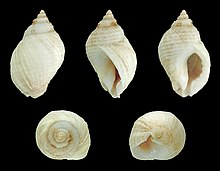
Shellfish is a colloquial and fisheries term for exoskeleton-bearing aquatic invertebrates used as food, including various species of molluscs, crustaceans, and echinoderms. Although most kinds of shellfish are harvested from saltwater environments, some are found in freshwater. In addition, a few species of land crabs are eaten, for example Cardisoma guanhumi in the Caribbean. Shellfish are among the most common food allergens.

Mussel is the common name used for members of several families of bivalve molluscs, from saltwater and freshwater habitats. These groups have in common a shell whose outline is elongated and asymmetrical compared with other edible clams, which are often more or less rounded or oval.
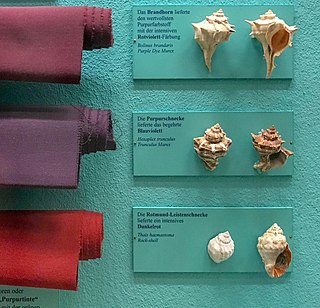
Tyrian purple, also known as, royal purple, imperial purple, or imperial dye, is a reddish-purple natural dye. The name Tyrian refers to Tyre, Lebanon. It is secreted by several species of predatory sea snails in the family Muricidae, rock snails originally known by the name Murex. In ancient times, extracting this dye involved tens of thousands of snails and substantial labor, and as a result, the dye was highly valued. The colored compound is 6,6′-dibromoindigo.
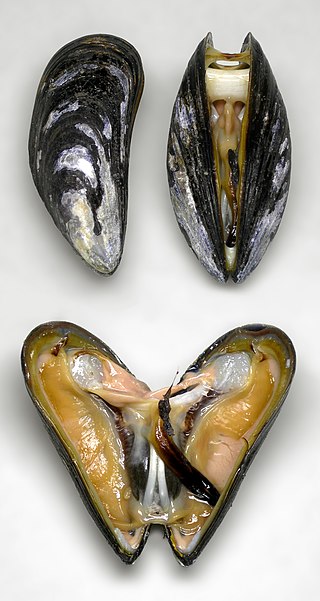
The blue mussel, also known as the common mussel, is a medium-sized edible marine bivalve mollusc in the family Mytilidae, the mussels. Blue mussels are subject to commercial use and intensive aquaculture. A species with a large range, empty shells are commonly found on beaches around the world.

Whelks are any of several carnivorous sea snail species with a swirling, tapered shell. Many are eaten by humans, such as the common whelk of the North Atlantic. Most whelks belong to the family Buccinidae and are known as "true whelks." Others, such as the dog whelk, belong to several sea snail families that are not closely related.

The knobbed whelk is a species of very large predatory sea snail, or in the US, a whelk, a marine gastropod mollusk in the family Busyconidae, the busycon whelks.

Fahamore is a townland and small hamlet/village on the Maharees peninsula in County Kerry. It consists of about 50 houses and one pub, Spillane's. Fahamore was historically much more populated than it is now as evidenced by two old schoolhouses in the village, one dating from 1849 and the other from 1911.
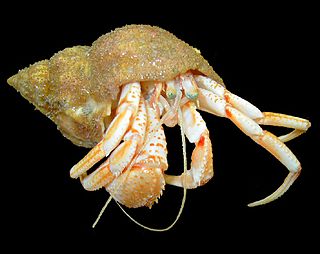
Pagurus bernhardus is the common marine hermit crab of Europe's Atlantic coasts. It is sometimes referred to as the common hermit crab or soldier crab. Its carapace reaches 3.5 centimetres (1.4 in) long, and is found in both rocky and sandy areas, from the Arctic waters of Iceland, Svalbard and Russia as far south as southern Portugal, but its range does not extend as far as the Mediterranean Sea. It can be found in pools on the upper shore and at the mean tide level down to a depth of approximately 140 metres (460 ft), with smaller specimens generally found in rock pools around the middle shore and lower shore regions, with larger individuals at depth. P. bernhardus is an omnivorous detritivore that opportunistically scavenges for carrion, and which can also filter feed when necessary.

Intertidal ecology is the study of intertidal ecosystems, where organisms live between the low and high tide lines. At low tide, the intertidal is exposed whereas at high tide, the intertidal is underwater. Intertidal ecologists therefore study the interactions between intertidal organisms and their environment, as well as between different species of intertidal organisms within a particular intertidal community. The most important environmental and species interactions may vary based on the type of intertidal community being studied, the broadest of classifications being based on substrates—rocky shore and soft bottom communities.
Imposex is a disorder in sea snails caused by the toxic effects of certain marine pollutants. These pollutants cause female sea snails to develop male sex organs such as a penis and a vas deferens.

Semibalanus balanoides is a common and widespread boreo-arctic species of acorn barnacle. It is common on rocks and other substrates in the intertidal zone of north-western Europe and both coasts of North America.

The purple shore crab is a common crab of the family Varunidae that is indigenous to the west coast of United States, Canada, and Mexico. H. nudus was first described in 1847 by Adam White, and in 1851, James Dwight Dana formally classified the species. H. nudus is a small, amphibious crab that is similar physically and behaviorally to Pachygrapsus crassipes and Hemigrapsus oregonensis. The purple shore crab is generally a dark purple color with olive green, red, and white spots. Mating season for H. nudus begins in mid-winter and larval crabs undergo 5 zoeal stages and a juvenile stage. Adult crabs mainly feed on algae but will occasionally scavenge other animals. H. nudus prefers inter-tidal and sub-tidal zones, and it can oftentimes be found sheltering under rocks or other debris. H. nudus demonstrates complex compensatory mechanisms to counteract fluctuating salinity and water oxygen concentrations, permitting it to live in a variety of different environments.

Pachygrapsus crassipes, the striped shore crab or lined shore crab, is a small crab found on both rocky and hard-mud soft seashores of the northeastern and northwestern Pacific Ocean. In North America, this species occurs from central Oregon, south through California to near Ensenada, Baja California, Mexico. There is an isolated population with a wide range disjunction at Bamfield on Vancouver Island, Canada. The western Pacific population, including both Korea and Japan is isolated with a divergence time from the eastern Pacific population estimated between 0.8 and 1.2 Mya.
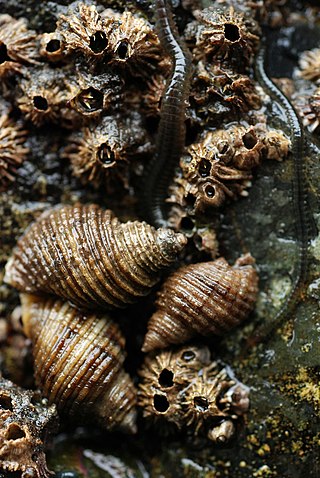
Nucella canaliculata, commonly known as the channeled dog winkle or the channeled purple, is a species of sea snail, a marine gastropod mollusk in the family Muricidae, the murex snails or rock snails. The shell grows to a maximum length of about 4 cm (1.6 in). This species is distributed in the northeastern Pacific Ocean from the Aleutian Islands to California.
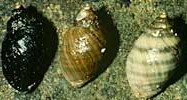
Nucella emarginata, common name the emarginate dogwinkle, is a species of medium-sized predatory sea snail, a marine gastropod mollusk in the family Muricidae, the murex snails or rock snails.

Nucella lamellosa, commonly known as the frilled dogwinkle or wrinkled purple whelk, is a species of sea snail, a marine gastropod mollusk in the family Muricidae, the murex snails or rock snails. This species occurs in the eastern Pacific Ocean, its range extending in the intertidal zone from the Aleutian Islands southward to central California.

Nucella ostrina, the northern striped dogwinkle, is a species of sea snail, a marine gastropod mollusk in the family Muricidae, the murex snails or rock snails. Other common names for this mollusk include emarginate dogwinkle, short-spired purple dogwinkle, striped dogwinkle, ribbed dogwinkle, emarginate whelk, ribbed rock whelk, rock thais, short-spired purple snail and rock whelk.

Pollicipes polymerus, commonly known as the gooseneck barnacle or leaf barnacle, is a species of stalked barnacle. It is found, often in great numbers, on rocky shores on the Pacific coasts of North America.


